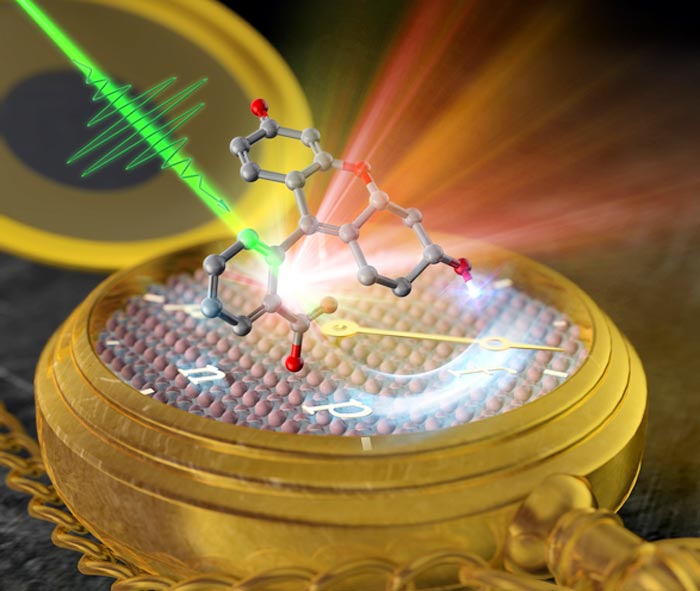Proton transfer between titania surface and dye observed for photocatalysis evaluation

When the titania and the dye adsorbed on its surface are irradiated with a femtosecond pulsed laser proton transfer from the dye molecules to the titania surface, the fluorescence of the deprotonated dye is observed.
Reprinted with permission from J. Phys. Chem. C, 2021, 125, 40. 21803-22396 (Supplementary Cover). Copyright 2021 American Chemical Society
A temporal change in the titania surface chemical state during the UV light irradiation is not observable through conventional methods such as regular FTIR or Raman spectroscopy. Therefore, a team led by Professor Hiromasa Nishikiori of Shinshu University’s RISM observed this reaction through time-resolved fluorescence spectroscopy. The team noted the monoanion transformation to the dianion (deprotonated species) of fluorescein “in the excited states” where the proton transfers from the fluorescein dye to the titania surface during the UV irradiation, which was not previously established by transient absorption spectroscopy.
Fluorescein, an organic dye sensitive to light and acidity/basicity was adsorbed on the surface of the titania as a probe molecule. The group used a time-resolved surface plasmon resonance (SPR) spectroscopy with a femtosecond pulsed laser. By using femtosecond pulsed laser SPR spectroscopy, the group was able to indirectly observe the proton transfer process from the dye to the titania surface and proved the formation of basic hydroxyl groups.
Observation through the UV irradiation time showed that the surface became more basic with OH groups on the surface of the titania which accepts the protons from the fluorescein monoanion. Time-resolved fluorescence probe observation using organic dyes that are sensitive to light and acidity/basicity is a very effective method for observing small light-induced behaviors (proton transfer processes) that occur on solid surfaces in a very short time.
The researchers were successful in observing the dianion and monoanion ratio of the fluorescein through the establishment of the SPR spectroscopy method. Professor Nishikiori hopes to continue to contribute to advances in hydrogen production with photocatalytic water splitting with the establishment of this simple method that enables researchers to observe and evaluate the activity of the photocatalysis.
For more information please read:
Observation of Excited State Proton Transfer between the Titania Surface and Dye Molecule by Time-Resolved Fluorescence Spectroscopy
https://pubs.acs.org/doi/10.1021/acs.jpcc.1c05843?ref=pdf
Journal: The Journal of Physical Chemistry C
DOI: 10.1021/acs.jpcc.1c05843
Method of Research: Experimental study
Subject of Research: Not applicable
Article Title: Observation of Excited State Proton Transfer between the Titania Surface and Dye Molecule by Time-Resolved Fluorescence Spectroscopy
Article Publication Date: 30-Sep-2021
Media Contact
Hitomi Thompson
Shinshu University
intl_ac@shinshu-u.ac.jp
Office: 81-263-373-529
All latest news from the category: Physics and Astronomy
This area deals with the fundamental laws and building blocks of nature and how they interact, the properties and the behavior of matter, and research into space and time and their structures.
innovations-report provides in-depth reports and articles on subjects such as astrophysics, laser technologies, nuclear, quantum, particle and solid-state physics, nanotechnologies, planetary research and findings (Mars, Venus) and developments related to the Hubble Telescope.
Newest articles

Innovative 3D printed scaffolds offer new hope for bone healing
Researchers at the Institute for Bioengineering of Catalonia have developed novel 3D printed PLA-CaP scaffolds that promote blood vessel formation, ensuring better healing and regeneration of bone tissue. Bone is…

The surprising role of gut infection in Alzheimer’s disease
ASU- and Banner Alzheimer’s Institute-led study implicates link between a common virus and the disease, which travels from the gut to the brain and may be a target for antiviral…

Molecular gardening: New enzymes discovered for protein modification pruning
How deubiquitinases USP53 and USP54 cleave long polyubiquitin chains and how the former is linked to liver disease in children. Deubiquitinases (DUBs) are enzymes used by cells to trim protein…


